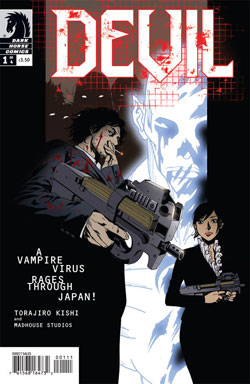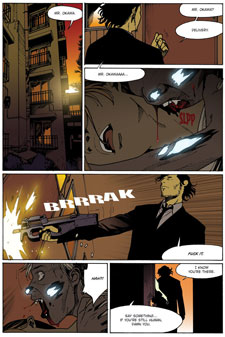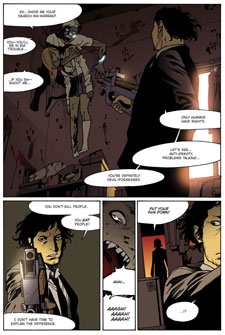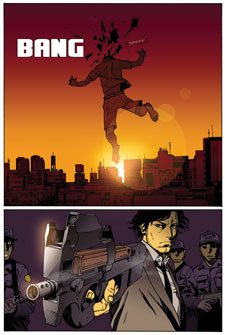 Logo handmade by Bannister
Column by Scott Green
Logo handmade by Bannister
Column by Scott Green

Manga Preview: Devil #1 By Torajiro Kishi and Madhouse Studios To be released by Dark Horse February 17, 2010
See that cover featuring a scruffy guy with gun and lit cigarette, with a darkly clad woman standing behind him? Pretty apparent that the content features a sci-fi-ish take on agents with automatic firearms chasing vampires? The qualities of anime, found in its best sellers, projected onto the American comic form? Well, Devil does exactly what it says on the tin. In that respect, the comic/manga is unimpeachable. 5 pages in, there's a "BANG" has a gunshot pops off the head of a fleeing vampire. There's a nice bit of anti-Twilight catharsis for you. In 20XX, the Serious Injury Chronic Bloodsucker Syndrome, SCBS, vampire virus began creating "devils." Infected who would die in days, at most months. Before succumbing, these carriers would aggressively attack other humans to drink their blood. Saga City police's Devil Investigation Section is tasked with corralling these threats. Devil opens with Investigator Takimoto aka Ramen Head aka the Punisher shooting open a door. A vampire hovers in the far upper corner of the blood smeared room, holding a bleeding, partially stripped young woman. The vampire demands that Takimoto show him a search warrant. Our lone wolf protagonist coldly responds, "only humans have rights," but before Takimoto can execute the blood sucker, his foil, Detective Migiwa shows up, flashing her badge. Backed by a squad of uniformed officers, she proclaims that, under the guidelines of the Special Civil Protection Law, she's present to arrest the SCBS infected. Things get out of hand, and Takimoto gets the opportunity to close matters in the manner that he had intended. The meeting of Takimoto and Migiwa and subsequent testy conversation is prologue to an action sequence that fills most of the rest of the 25 page issue. She thinks he's out of control. He thinks she's out of her depth. Together, they're on a collision course with the most dangerous of the infected. Devil's identity is strange and exciting. It's anime-sh manga created by someone with a unique profile, released as a monthly comic. Strip that away. Divorse it from that context. Just look at the cover. You probably have a good idea of what you're getting from Devil. It's a punchy vampire action story - not as mindless as Underworld or as smart as Guillermo del Toro's The Strain. It doesn't stand out either for its flaws or its merits. How it reads is far less revolutionary than what it is. As such, if you come in cold, there's no reason to be disappointed. If you're wondering what a Torajiro Kishi/Madhouse comic would be like, you might leave cold. Before anime distributor Geneon USA left the business, they released Texhnolyze, a somewhat Cronenbergian cyberpunk concerning prosthetic body parts, from Serial Experiments Lain creators Yoshitoshi ABe and Chiaki J. Konaka. At the time, there were conversations about how an anime like Texhnolyze, with its adult male characters, with its run down tech look, wouldn't be made without North American interest. Much to the woe of parties like Geneon, there wasn't actually enough interest, or at least draw on the consumer's wallet, to support works like Texhnolyze. The point is that there is a profile of anime that attracts and to some extent is made for the North Americans who will occasionally buy a work of anime. Since the anime boom years, when anime like Ghost in the Shell: Stand Alone Complex have been produced, it's been at least in part because that sort of work interests North American audiences. In most conversations, using anime and manga interchangeably is a mistake. They are related fields, with manga providing a large slice of anime's IP. That said, their Japanese audiences aren't the same. In North America, plenty follow one and not the other. They are neither the same business in Japan nor in North American. Devil is an exception. Not just because it's in color, but because it was developed with involvement from Madhouse, the anime studio founded by animators from Osamu Tezuka's Mushi Productions, including Masao Maruyama, Osamu Dezaki, Rintaro, and Yoshiaki Kawajiri. When it comes to older audience fare, as opposed to kiddie works like Pokemon and Yu-Gi-Oh or the unique profile of Ghibli's production, no other studio can claim to have commanded as much international attention. Madhouse has been the home to an abundance of cross-over hits including the Satoshi Kon movies (Paprika, Tokyo Godfather), most of the anime adaptation of shojo creating mega-group CLAMP (Card Captor Sakura, X), Kawajiri's bloody, sexualized violence (Ninja Scroll, Demon City Shinjuku, Wicked City) and other works that caught on in the US by happenstance or design, from ADV Films inaugural title Devil Hunter Yohko to the more recent Black Lagoon. Key elements of these cross-over hits don't overlap the key elements of what dedicated anime buyers/watchers expect. It's the difference between blood soaked, shower scene punctuated movies and OVA that were marveled at between Akira and the ignition of the anime boom and cute girls and dating scenarios with which anime is now more frequently associated. Devil has those cross-over bait elements, like hard men and graphic spectacles, projected onto manga. What's strange about this design is that it is carried out by Torajiro Kishi. I haven't seen Kishi's Bloody Mary, about a succubus fighting a demon war in Shibuya, or i.d., a risquÈ martial arts manga published in Gekkan Young King, an anthology that specializes in that sort of work. There is not much in the way of Kishi manga licensed for release in North America, but his work is known well enough that he has a reputation. And, that reputation doesn't spell out go-to manga artist for vampires meets Ghost in the Shell. There's Colorful, which ran in Weekly Young Jump (home of Elfen Lied, Gantz). Those adventures in how males overact to the slightest sexual provocations were adapted into a series of ironically stupid anime shorts for the late night series Wonderful. Collected in one volume, the Colorful anime was a surprisingly fun, underrated released by ADV Films. There's yuri (featuring lesbian relationships) josei (for adult women) title Kiss of Mars, about an odd couple comprised of a rebellious girl and a girl conforming to Japanese ideas. And, there's Maka Maka, a color work, serialized online and in adult magazine Pent-Japan Special about the sexual relationship between two lesbian women, released in North America by Media Blasters and more well regarded than one might expect from a work with that premise, from a male writer. The chief vehicle for manga distribution in Japan is anthologies, yet with the possible exception of Naruto/One Piece home Shonen Jump, these have always struggled in North America. Early manga released in North America arrived in varied formats; a spot in a magazine like Heavy Metal or Epic Illustrated; a paperback for Barefoot Gen. As more manga began being released in North America, and began being released in more focused commercial endeavors, more of it began being released in the 17 x 26 cm, stapled format familiar from monthly comics. Then, manga turned to graphic novel collections, began taking a commanding presence in book stores, and developing an audience, which did not entirely overlap other comic buyers. In 2002, Tokyopop unveiled its "Authentic Manga" format, in which works were released in their original, right to left page orientation, priced at $10 for a graphic novel. With that, an expectation was set. When, after an eleven year run, Dark Horse ended the monthly release of Blade in the Immortal in 2007, it seemed like something for a last hurrah for manga released in the North American comics/issue format. Now, with Devil, it's back. To guess a reason, I'd have to go with the cross-over nature of the work and an attempt to sell it to readers of American comics who don't typically buy manga. When monthly Blade of the Immortal ended, it seemed like manga had moved past its need to utilize the vehicle that was familiar to comic shop frequenters. I wouldn't call Devil a step back so much as an attempt to re-explore the market. A manga writer can accomplish plenty in 25 pages. It's about the size of a chapter in most manga anthologies. And, there's nothing more important than the first chapter of a manga. Jonathan Clements made the point in Schoolgirl Milky Crisis that that first chapter is the stake in the ground on which careers are launched. To paraphrase another topic expert, Ed Chavez, what's really essential in manga is characters. The first chapter of One Piece features the irrepressible would-be pirate king Monkey D. Luffy as a young child, attempting himself to a tavern full of veteran sailors by driving a knife into his own face. Berserk opens with Guts copulating with a succubus, then, as she takes on a hideous form and is about to consume him, he shoves the mini cannon, mounted where an arm used to be, into the demon's mouth and blows its head off. That's how to sell a memorable character. The opening chapter of Devil establishes types rather than characters. Takimoto smokes. He breaks the rules to terminate with extreme prejudice. "Punisher" is right. Not because he resembles the Marvel character, but because just drop a functional label on this character. That's what's there. He doesn't need to be more for Devil to function, but to leverage the strengths of manga, he and Migiwa needed some specific vitality. While I'm not convinced that Devil's characters will progress beyond types, I'm wondering about the series' narrative. It's only four issues long. There isn't much of a track record for manga of that length. (Tsutomu Nihei's Wolverine: Snikt! ran a somewhat comparable 6 issues) As such, I'm not quite sure what can be accomplished. Is it going to be a straight exercise in threat elimination? Is it going the well worn "what is humanity" route? Or, is there a more distinct twist? It does seem to be pushing buttons such that I'm wondering if it is going to develop the handling of vampirism as a metaphor for the handling of other diseases. It's victims are literally demonized. The ham-fisted "SCBS" designation is a bit reminiscent of the early naming of AIDS as GRID and 4H disease. I'm not sure if it is going in that direction, or, if it does go in that direction, it can be handled thoughtfully, but I am a bit intrigued by the prospect. As stated before, I'm familiar with some Kishi work, but not the action oriented bits of his opus. What I've seen in Devil reinforces my impression that he was a curious partner for this work. His approach evokes neither the concrete solidity of a work like Ghost in the Shell: Stand Alone Complex or the exploitation leeriness of Kawajiri work. A very bad thing happens to a young woman late in the issue. Then a really gruesome thing happens as a consequence. Think face hugger, then chest burster. It's not that, but the comparison is useful. Kishi's style of rendering people has a soft look that is a bit incongruous with the severity. As with the character details, it is not distracting, but it is not enhancing either. If there's a benefit, it is that it provides a ghastly spectacle without it really being too objectionable. Car chases and run and gun art difficult action scenarios to effectively convey in manga/comics. The screeching, changing vectors of engines. The rapid way in which lethal force is employed with firearms. If it's more than just spaced out images blocking out the action, getting the timing and spacing right is not an easy fit for comic panels. Some manga artists do it exceptionally well. Gunsmith Cats' Kenichi Sonoda is the first to come to mind. His obsession and care was evident. Normal guy and exotic girls versus ghost cats manga Geobreeders offered little in way of intelligence or originality, but few in manga could convey the speed and danger of stunts and chases the way Akihiro Ito could. Firearms represent a subject that I know very little about. Kishi might have it exactly right. I wouldn't known. However, Takimoto holding his automatic weapon in one hand, arm fully extended doesn't look right to me. Doesn't the gun have a large stock for a reason? Beyond that, Torajiro Kishi isn't a superlative guns and cars action manga artist, but he is reasonably skilled ay conveying these matters. It's a large panels approach in which dramatic angles are employed to full effect rather than a tight attention to frame to frame transitions. The results are sufficiently coherent and cinematic. It wasn't too difficult to set hopes for Devil too high. It might be getting released in the same time frame as Halo Legends, and Dante's Inferno: a Animated Epic, but it's not too often that you get this sort of intended cross-over work, put together by interesting anime/manga talent. And make no mistake, Madhouse and Torajiro Kishi are exciting parties to have attached to a work put together for a North American audience. It's not entirely a letdown, and its problems don't seem to be a function of product development forcing a concept onto creative. Devil lacks any critical flaw, but it doesn't coalesce into an original or inspired take on the material either.





